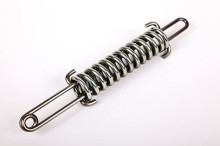Extension Springs
Contents |
[edit] Introduction
A wide range of springs are available for use in a huge number of applications, many which are not obvious. Extensions springs are just one of the types of springs that are used in everyday objects.
Extension springs are wound particularly tightly, meaning that they are loaded in tension. On each end of the spring, there is a hook or a loop, so when something is attached to each end of the spring, tension is applied and the spring attempts to bring the two items back together.
When pressure is applied to either end of the spring, the spring extends with differing tension dependent on the manipulation of the tension of the wind.
[edit] Materials
Just as with other types of springs, extension springs can be made from a range of materials including:
- High carbon steel.
- Stainless steel.
- Alloy steels.
- Non-ferrous alloys.
- High-temperature alloys.
These materials have different properties, so will be chosen according to the requirements of the spring.
[edit] Application 1: Trampolines
Extension springs are commonly used in trampolines due to their energy-storing properties. As the net of the trampoline has pressure applied by the weight of a person, tension is applied to the spring which then attempts to snap back into its original position. This allows for the action of bouncing on the trampoline.
[edit] Application 2: Toys
Very small extension springs may be used in toys that feature a throwing mechanism. The mechanism may allow for a part of the toy to be pulled back, with the release expelling enough energy to launch the item thrown by the toy.
[edit] Application 3: Prison Springs
A slightly different form of extension spring is the drawbar spring. This spring has three parts with two ‘U’ shaped wire forms being inserted into the middle of the extension spring. If the two ends of the wire forms are pulled apart, the spring is compressed. This means that there is a limit to the compression, thus making it a particularly safe spring to use in applications where this must be limited. For example, they may be used to hold safety netting between landings in prisons. The design of the spring means that should someone fall onto the netting, there would be enough movement in the spring to allow for some movement, but the spring could not extend completely which could cause the netting to collapse.
[edit] Find Out More
Related articles on Designing Buildings Wiki
- Compression Springs
- E-spring
- Spring materials.
- Key Qualities of Springs
- Spotlight on Compression Springs
- History of the Spring
- Spotlight On: Flat Springs
- The Multiple Uses of Compression Springs
- The Difference Between Tension and Torsion Springs
- The Properties of Die Springs
- Torsion Springs and Their Benefits
- Springs in Structures
- Types of spring.
--Airedale Springs 10:35, 20 Sep 2017 (BST)
Featured articles and news
Infrastructure that connect the physical and digital domains.
Harnessing robotics and AI in challenging environments
The key to nuclear decommissioning and fusion engineering.
BSRIA announces Lisa Ashworth as new CEO
Tasked with furthering BSRIA’s impressive growth ambitions.
Public buildings get half a million energy efficiency boost
£557 million to switch to cleaner heating and save on energy.
CIOB launches pre-election manifesto
Outlining potential future policies for the next government.
Grenfell Tower Inquiry announcement
Phase 2 hearings come to a close and the final report due in September.
Progress from Parts L, F and O: A whitepaper, one year on.
A replicated study to understand the opinion of practitioners.
ECA announces new president 2024
Electrical engineer and business leader Stuart Smith.
A distinct type of countryside that should be celebrated.
Should Part O be extended to existing buildings?
EAC brands heatwave adaptation a missed opportunity.
Definition of Statutory in workplace and facilities management
Established by IWFM, BESA, CIBSE and BSRIA.
Tackling the transition from traditional heating systems
59% lack the necessary information and confidence to switch.
The general election and the construction industry
As PM, Rishi Sunak announces July 4 date for an election.
Eco apprenticeships continue help grow green workforce
A year after being recognised at the King's coronation.
Permitted development rights for agricultural buildings
The changes coming into effect as of May 21, 2024.























